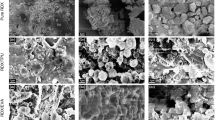Abstract
In order to optimize formulations of PBX based on Hexanitrohexaazaisowurtzitane (HNIW) and meet the application in mixed explosive, the mold powder of HNIW coated by varied binders was obtained by aqueous suspension technology. Several particle sizes of graphite were added as additive with a 0.5 % mass ratio. The experiment results showed that fluorine resin (FPM) was better than polyurethane and cis-butadiene rubber when the mass percentage of binders was fixed at 4 %. The characteristic height of HNIW/FPM (96/4) mold powder was at 28 cm (2.5 kg hammer), while that of the neat HNIW was at 15 cm merely, and the friction explosion probability fell from 100 to 70 %. The addition of flake graphite with proper grain size would reduce the mechanical sensitivity of HNIW and improved the fluxion property of HNIW-based mold powders. The thermal stability characteristic of HNIW FPM (96/4) and HNIW/FPM/G (96/4/0.5) were studied by thermogravimetric analysis (TG) at 10 °C min−1, the peak decomposition temperatures were at 251 and 250 °C, which were closed to that of neat HNIW(249 °C) and also identified superior thermal stability of compound.









Similar content being viewed by others
References
Simpson RL, Urtiev PA, Ornellas DL, et al. CL-20 performance exceeds that of HMX and its sensitivity is moderate. Propell Expl Pyrotech. 1997;22(5):249–55.
Lobbecke S, Bohn MA, Pfeil A, et al. Thermal behavior and stability of HNIW (CL 20). In: Proceedings of the 29th international annual conferrence on ICT, Karlsruhe, Germany, 1998; 145, 1–15.
Nielsen AT. Synthesis of polynitropolyaza caged nitramines chemical propulsion information agency, 1987; Publication no.473.
Ordzhonikidze O, Pivkina A, Frolov Yu, Muravyev N, Monogarov K. Comparative study of HMX and CL-20. J Therm Anal Calorim. 2011;105:529–34.
Wang X, Peng CZ. Development of hexanitrohexaazaisowurtzitane at abroad. Chin J Explos Propellants. 2007;30(5):45–8. (In Chinese).
Nair UR, Sivabalan R, Gore GM, et al. Hexanitrohexaazaisowurtzitane (CL-20) and CL-20 based formulations (Review). Combust Explos Shock Waves. 2005;41(2):121–32.
Robert LH. High performance castable CL-20 explosive. In: Insensitive munitions and energetic materials technical symposium IMEMTS 2006, San Francisco, CA, 2004; Nov 15–17.
Foltz MF. Thermal stability of ε-hexanitrohexaazaisowurtzitane in an estane formulation. Propell Expl Pyrotech. 1994;19(2):63–9.
Tarver CM, Simpson RL, Urtiew PA. Shock initiation of an (epsilon)-CL-20-estane formulation. In: Proceedings of the American physical society biennial conference on shock compression of condensed matter, Seattle, WA, United States; 1995
Bircher HR, Mader P, Mathiece J. Properties of CL-20 based high explosives. In: Proceedings of the 29th international annual conference of ICT, Karlsruhe, Germany; 1998, 94, 1–14.
Samson S, Ushadevi R, Girish M, et al. Studies on an improved plastic bonded explosive (PBX) for shaped charges. Propell Expl Pyrotech. 2009;34:145–50.
Liao SR, Luo YJ, Sun J, et al. Synthesis of waterborne polyurethane for coating on HNIW. Adv Mater Res. 2011;194–196:2425–8.
Liao SR, Luo YJ, Sun J, et al. Synthesis of waterborne polyurethane and its coating on CL-20. Chin J Energ mater. 2006;14(5):336–8. (In Chinese).
Chen LY, Zhao SX, Yang PJ, et al. The coating and desensitization of CL-20. Chin J Energ Mater. 2006;14(3):171–3. (In Chinese).
Xu XJ, Xiao JJ, Huang H, et al. Molecular dynamic simulations on the structures and properties of ε-CL-20(0 0 1)/F2314 PBX. J Hazard Mater. 2010;175:423–8.
Gibbs TR, Popolato A, editors. LASL explosive property data. Berkeley, CA: University of California Press; 1980.
Dong HS, Zhou FF. High energy explosives and correlative physical properties. Beijing: Science Press; 1984.
Lee JS, Jaw KS. Thermal behaviors of PETN base polymer bonded explosives. J Therm Anal Calorim. 2009;93(3):953–7.
Bouma RHB, Duvalois W, et al. Characterization of a commercial grade CL-20: morphology, crystal shape, sensitivity and shock initiation testing by flyer impact. In: Proceedings of the 31st international annual conference of ICT, Karlsruhe, Germany; 2000, 105, 1.
Ou YX, Liu YQ. High energy density compounds. Beijing: National Defense Industrial Press; 2005.
Huang H. Particle grade technique and application on energetic materials. Chin J Energ Mater. 2001;9(4):161–4. (In Chinese).
Zhang JL, Lv CL, Wang JY, et al. Selectivity of the sensitivity of the sub-micron explosive. Explos Shock Waves. 2004;24(1):59–62.
Hu QX, Lv ZJ. Study on desensitizing effect of TATB, wax and graphite. Chin J Energ Mater. 2004;12(1):26–8.
Zhang CY. Computational investigation on the desensitizing mechanism of graphite in explosives versus mechanical stimuli: compression and slide. Phys Chem B. 2007;111:6208–13.
Lee JS, Jaw KS. Thermal decomposition properties and compatibility of CL-20, NTO with silicone rubber. J Therm Anal Calorim. 2006;85(2):463–7.
Richard T, Marie V, Queenie SMK, et al. Thermal study of HNIW (CL-20). Thermochim Acta. 2005;433:105–15.
Geetha M, Nair UR, Sarwade DB, Gore GM, Asthana SN, Singh H. Studies on CL-20: the most powerful high energy material. J Therm Anal Calorim. 2003;73:913–22.
Acknowledgements
The authors pay tribute to Prof. Jinglin Zhang and Prof. Baoguo Wang of NUC for providing expert technical assistance.
Author information
Authors and Affiliations
Corresponding author
Rights and permissions
About this article
Cite this article
Yu, L., Jiang, X., Guo, X. et al. Effects of binders and graphite on the sensitivity of ε-HNIW. J Therm Anal Calorim 112, 1343–1349 (2013). https://doi.org/10.1007/s10973-012-2679-6
Received:
Accepted:
Published:
Issue Date:
DOI: https://doi.org/10.1007/s10973-012-2679-6




